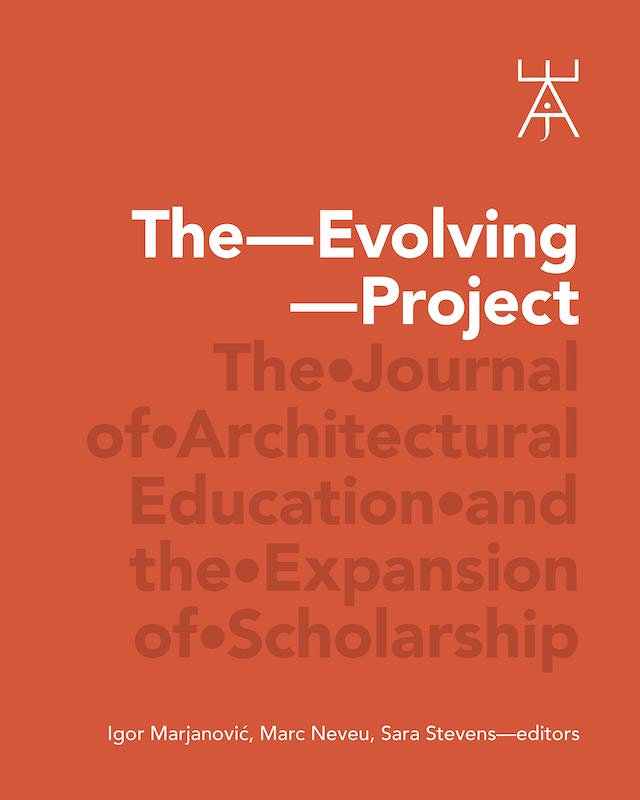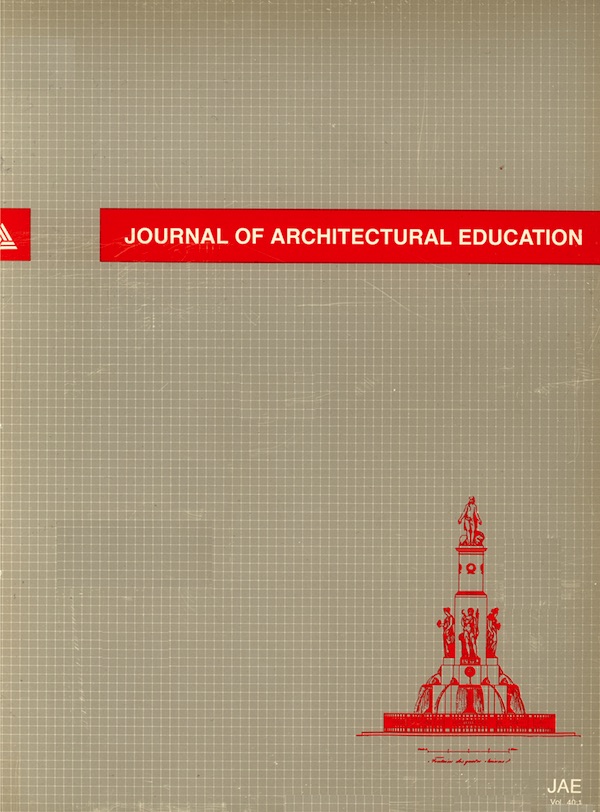The Evolving Project
The Evolving Project: The Journal of Architectural Education and the Expansion of ScholarshipEdited by Igor Marjanović, Marc J. Neveu, Sara StevensORO Editions, April 2021Paperback | 8 x 10 inches | 300 pages | English | ISBN: 9781951541699 | $40.00PUBLISHER'S DESCRIPTION:Through a selection of essays from the Journal of Architectural Education (JAE) and its 75-year history, this volume showcases not only the development of a single publication but also the evolution and expansion of the entire discipline. This book celebrates the rich history of the JAE, which is the longest continually running peer-reviewed journal in the discipline of architecture, as a major platform for the dissemination of new pedagogical and scholarly ideas. From discourses on drawing and design processes to issues of new media and the environment, The Evolving Project is a journey in space and time that documents the changing project of architectural education after World War II—namely its transformation from a professional training ground to an intellectual platform that allowed architectural educators to boldly engage the larger social, cultural, and political issues of their time.Igor Marjanović is the William Ward Watkin Dean of Rice Architecture. Marc J. Neveu is the head of the architecture program at the Design School at Arizona State University. He is the current executive editor of the biannual peer-reviewed Journal of Architectural Education. Sara Stevens is an architectural and urban historian. She is an assistant professor of architectural and urban design history and chair of urban design at the School of Architecture and Landscape Architecture at the University of British Columbia in Vancouver. REFERRAL LINKS: dDAB COMMENTARY:The first issue of the Journal of Architectural Education, published by the Association of Collegiate Schools of Architecture (ACSA), came in the spring of 1947. Even though it was first edited by Turpin C. Bannister, a prominent architectural historian who also played a part in the early years of the Journal of the Society of Architectural Historians, issue number one was devoted to architectural research. A focus on research makes sense in 1947, just two years after the end of World War II, particularly given that many technologies and manufacturing processes developed during the war would be applied to "peaceful" uses in the ensuing years and decades. According to the editors of The Evolving Project, a collection of notable contributions to JAE between 1947 and 2019, "as the decades progress, the role of research in the field becomes more prominent [...] paralleling the rise of the research university and the societal shift toward new knowledge production that so characterized the postwar years." The importance of research is accentuated by the organization of the book, which puts more than fifty essays into four thematic chapters: research, environment, pedagogy, and politics.Before that 1947 inaugural issue there was The Evolving Architect, a prewar bulletin that JAE evolved out of. Marc J. Neveu, the most recent executive editor of JAE, apparently paraphrased the name of that earlier publication in his March 2018 editorial in JAE's pages, "The Evolving Project." But what is meant by "the evolving project," the phrase that carried through to the title of this collection of essays edited in part by Neveu? In the introduction to "Research," the first of the book's four sections, the other two editors, Igor Marjanović and Sara Stevens, describe architecture's repositioning of itself relative to science, technology, and society as "the evolving project of architectural research." (emphasis in original) Although this assertion elevates the research section of the book above the others, the editors also describe the intertwining nature of the chapters that follow: "pedagogy as a uniquely architectural territory of research studios, seminars, and publications that saw architecture as environment (spatial or ecological, described by technical or visual means) or architecture as politics (a form of spatial practice laden with questions of power, governance, and who we are, both individually and collectively)." As such, research and pedagogy are the main "meat" of this collection and therefore the ones I focused on in perusing the book.The Research chapter starts with an essay from the very first issue, "The Architect Looks at Research" by Walter A. Taylor, and ends in 2009, with Avigail Sachs's "The Postwar Legacy of Architectural Research." In between are nearly a dozen contributions that are anchored by a couple written by Denise Scott Brown (she is the only author featured more than once): "On Formal Analysis as Design Research" (issue 32:4, 1979) and "With People in Mind" (35:1, 1981). The former touches on what is definitely the most influential piece of research ever carried out in the context of a design studio: "Learning from Las Vegas, or Formal Analysis as Design Research," the 1968 Yale U

ORO Editions, April 2021
Paperback | 8 x 10 inches | 300 pages | English | ISBN: 9781951541699 | $40.00
PUBLISHER'S DESCRIPTION:
REFERRAL LINKS:
IMAGES:








